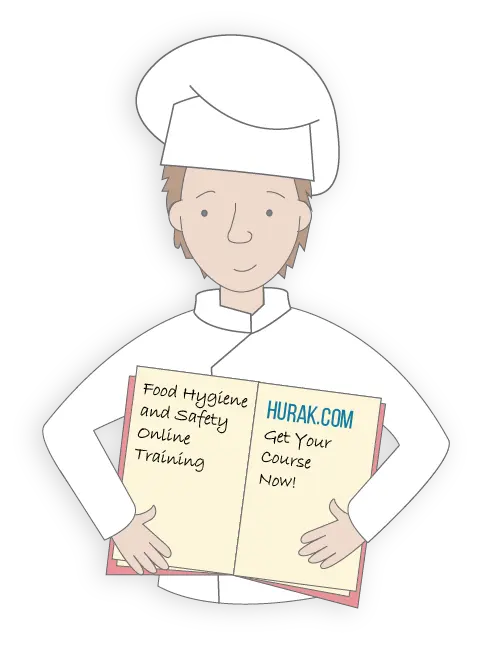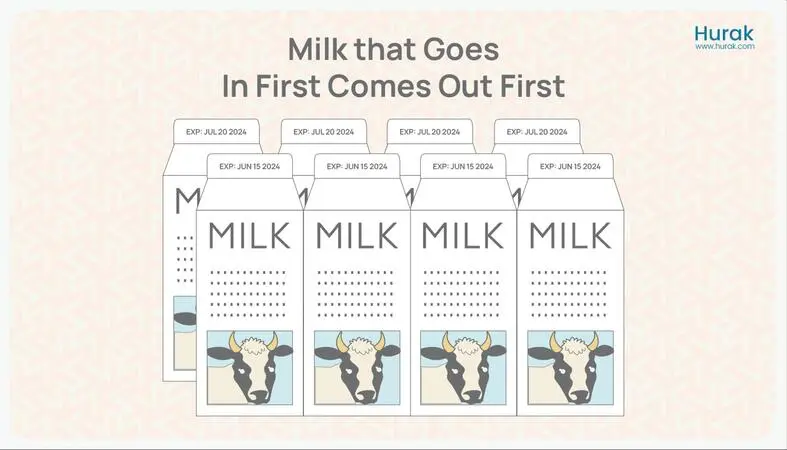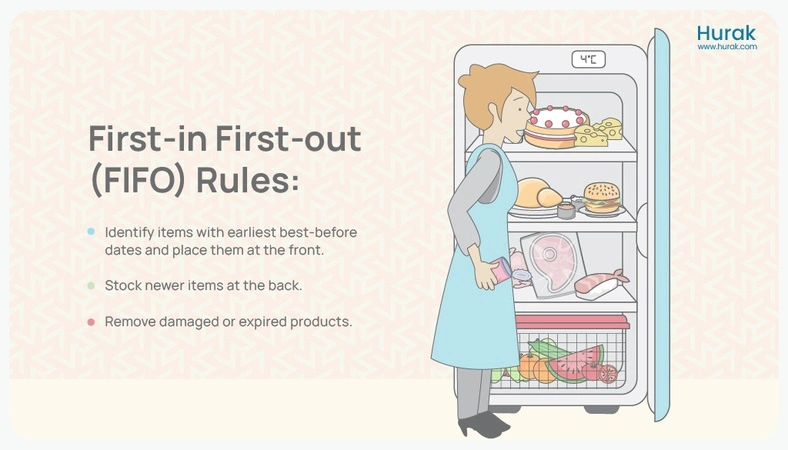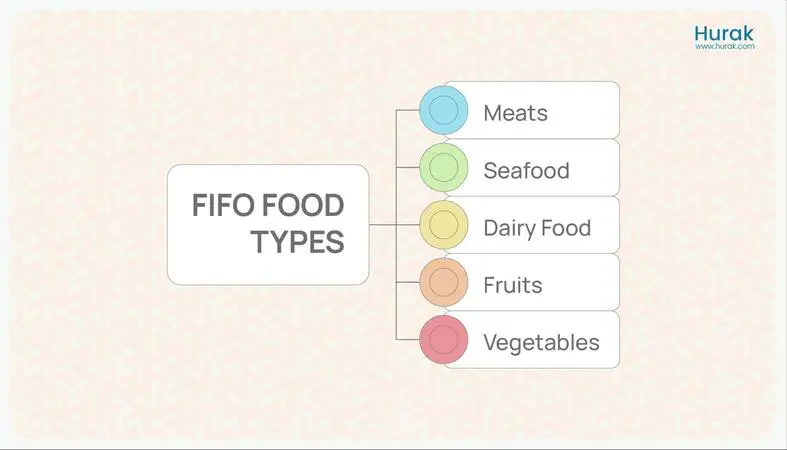FIFO stands for First-In First-Out. In the food industry, FIFO is a storage method that allows for the correct placement of food. The food with the earliest best-before or expiry date is placed at the front or on top in a visible position. The item with a later expiration date is placed on the back.
What is FIFO: Explaining the Acronym
FI: First-In – Stocked items that are manufactured or produced first are stored in the warehouse or displayed on the shop racks.
FO: First-Out – The products that are stocked first must be consumed first. This is done by placing them at the front of a storage area or a retail shelf.
The First-In First-Out (FIFO) Rule
The system of FIFO stock rotation is a type of inventory management that confirms a product is used or purchased before its shelf life runs out. Stocked items from the warehouse are placed in the market for sales in such a way that the one with the nearest expiry date is placed at the front display.
Items to be expired later are placed at the back and rotate to the front only after the short-dated products are used first. Shelf life of a product is the duration of time for which the product remains usable. After the recommended shelf life of an item, the quality diminishes and it is best to discard it. This method produces a minimum amount of waste. The FIFO method has a branch called FEFO.
Get Online Food Safety Courses
Food Hygiene And Safety
Check the CourseRated Excellent
on major review sites

FEFO: First-Expired First-Out
Products with the nearest expiry dates come out of the storage stock first.
First In First Out is a storage rule that arranges stored food according to their respective best-before or use by dates. The stock of food items are rotated based on their manufacturing timelines.
Example of the FIFO System: Milk Pack Stock Rotation
From Storage to Sale
The milk pack produced or manufactured first is stocked in earlier at the warehouse. It is transferred to the retail market and is shelved at the front display. The upcoming stock is placed at the back.
From Sale to Consumption
You go grocery shopping at the same retail shop. You buy two milk packs. Milk pack A expires in two days. Milk Pack B expires in four days. You place the long-dated milk pack (expiring in four days) at the back of the refrigerator. The short-dated milk pack that expires in two days is placed at the front of the refrigerator.
The next morning, you take out the milk that was expiring in two days and use it for your breakfast. This is an example of the applied FIFO method.

New items are long-dated with late expiration dates. They are placed at the back of a fridge or a shelf. Old items are short-dated and have upcoming expiration dates. They are placed at the front. This storage technique confirms that old items are used before they are expired. Once they are consumed, new items are placed at the back and placed in front to be used ahead of their best-before dates.

Practising FIFO in Food Safety
Stock rotation of food items using the FIFO method is an important part of food safety and hygiene. The First-In First-Out method is a practical rule applied for fridge storage or shelf stacking. Old and new items are required to be replaced regularly based on their expiration dates. Four common FIFO measures to implStock rotation is crucial for maintaining food safety and hygiene standards, and the FIFO (First-In First-Out) method is a practical approach to ensure freshness. Here’s a breakdown of four key FIFO measures that can be implemented:
Best-Before Labelling
All food items should be labelled with their best-before dates. This helps staff identify which items need to be used or sold first to prevent wastage and ensure that customers receive fresh products.
Daily Checks
Conduct daily inspections of stock to identify items nearing their expiration dates. By regularly monitoring inventory, staff can promptly remove expired items from shelves and replace them with fresh ones.
Timely Stock Rotation
Implement a systematic process for rotating stock based on their expiration dates.
Older items should be placed at the front of storage areas, while newer items are stored behind them, ensuring that older products are used or sold first.
Staff Training
Provide comprehensive training to all staff members on the importance of stock rotation and FIFO principles. Educate employees on how to identify expiration dates, conduct daily checks, and properly rotate stock to maintain food safety standards.

Why Use FIFO?
First-In First-Out is the cornerstone for maintaining food safety. It minimises food waste in food retail outlets and households. Timely stock rotation helps save money by allowing all items to be utilised. First-In First-Out complies with standard safety procedures (HACCP) and maintains food quality.
HACCP Compliance:
FIFO maintains food quality and prevents possible contamination of food. It facilitates Hazard Analysis and Critical Control Points (HACCP) compliance, which is a systematic approach for contamination control.
Inventory Management:
FIFO helps businesses manage their inventory effectively by confirming that older stock is used first. This prevents products from expiring and becoming wasted. By rotating stock in this manner, businesses can keep track of their inventory levels and avoid overstocking or understocking.
Reduces Food Waste:
Implementing FIFO reduces food waste by making sure that items are used or sold before they reach their expiration dates. By preventing food from going bad and being thrown away, businesses can save money and minimise their environmental impact.
Food Safety and Hygiene:
FIFO maintains food safety and hygiene standards by reducing the likelihood of serving expired or spoiled food to customers. It helps prevent foodborne illnesses and promote fresh and safe products.
Consumer Satisfaction:
FIFO principles improve consumer satisfaction by consistently offering fresh and high-quality products. Customers are more likely to return to establishments that prioritise food safety and hygiene, leading to increased loyalty and positive reviews.

First-In First-Out Food
The FIFO food stock rotation is appropriate for managing perishable food items and those products with a short shelf life.
- Fruits
- Vegetables
- Dairy Food
- Seafood
- Meats

Conclusion
The First-In First-Out (FIFO) in food safety is a stock rotation method that allows punctual use of food items. Products which are stored first are used first. The stock is rotated according to the relative expiry dates labelled on each product. It is applicable to perishable food products that have a short shelf life. The FIFO inventory management reduces food waste and cost. It also plays a part in standardising the process of the food supply chain. The main FIFO practices include proper labelling of best-before dates, regular checks and timely rotation of the stock by trained staff. This contributes to food safety and hygiene and has economic benefits in warehouses, retail outlets, and households.




